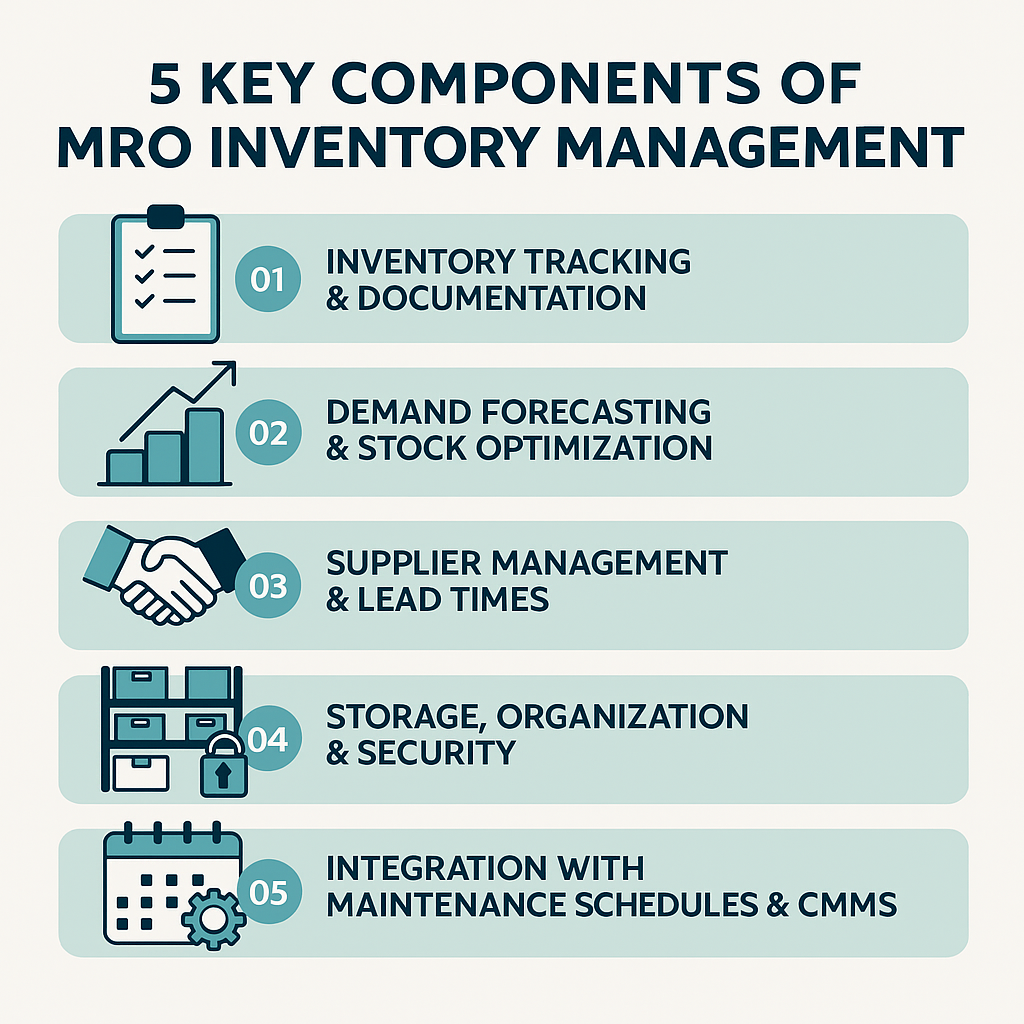MRO inventory management refers to the process of effectively tracking, controlling, and optimizing inventory used for Maintenance, Repair, and Operations (MRO) activities.
Effective MRO inventory management isn't just about tracking parts—it's a strategic move to protect your bottom line. According to the 2024 State of Industrial Maintenance Report, 59% of facilities that successfully reduced unplanned downtime costs credited their success to improved MRO parts inventory management. With downtime costing businesses tens of thousands of dollars per hour, proactively managing your MRO inventory has never been more essential.
In this article, you’ll learn exactly what MRO inventory management involves, why it matters to your organization, and which strategies can help you streamline processes, reduce costs, and enhance operational performance.
What Is MRO Inventory Management?
MRO inventory management is the organized process of tracking, storing, and replenishing the spare parts, tools, and consumables used for maintenance, repair, and operations across your facility. This includes everything from replacement bearings and safety gear to lubricants and cleaning supplies—items critical for supporting daily production, equipment uptime, and workplace safety.
Unlike finished products or raw materials, MRO items are not part of your end product. Instead, they support your ongoing operations by ensuring equipment reliability, workplace safety, and uninterrupted production.
Why Is MRO Inventory Management Important?
The way you manage MRO inventory shapes your operation’s reliability, cost control, and compliance. Here are some of the key benefits your organization can achieve with a disciplined approach to MRO inventory management:
1. Reduces Operational Downtime
A well-managed MRO inventory ensures that critical spare parts and supplies are always available when you need them. This reduces the time spent searching for or waiting on replacement parts, minimizing unplanned equipment failures and keeping production on schedule. The result is fewer costly interruptions and more consistent output.
2. Impact on Cost Control and Procurement Efficiency
Effective MRO inventory management helps you avoid unnecessary purchases and reduce excess stock. With greater visibility into what’s on hand, you can consolidate orders, negotiate better pricing, and minimize rush shipments. This approach streamlines your procurement process, lowers carrying costs, and supports more accurate budgeting.
3. Ensuring Safety and Regulatory Compliance
Accurate MRO inventory management plays a critical role in meeting safety standards and regulatory requirements. When essential spare parts, safety equipment, and compliance-related supplies are always available and properly tracked, you reduce the risk of workplace incidents and regulatory violations. Reliable recordkeeping also supports audits and demonstrates that your operation meets industry and legal obligations.
4. Extending Equipment Life Cycles and Reducing Waste
Consistent access to the right MRO supplies allows you to perform timely maintenance and repairs, extending the useful life of your equipment. Well-managed parts and consumables keep assets operating at peak efficiency and reduce premature failures. This minimizes unnecessary equipment replacement, supports cost savings, and advances your sustainability goals.
Key Components of MRO Inventory Management

1. Inventory Tracking and Documentation
Accurate inventory tracking is the foundation of effective MRO management. By systematically documenting each part—its location, usage history, and stock levels—you gain full visibility into your supplies.
This approach prevents lost or misplaced items, supports timely replenishment, and helps maintain compliance with audit requirements. Reliable documentation enables informed decision-making and streamlines maintenance workflows across your facilities.
2. Demand Forecasting and Stock Optimization
Successful MRO inventory management depends on anticipating future needs and maintaining the right amount of stock. Demand forecasting uses historical usage data, maintenance schedules, and production trends to predict which parts and supplies you’ll need—and when.
By optimizing stock levels based on this insight, you avoid both costly overstock and the risks of running out. This approach keeps your operation prepared, reduces excess inventory, and ensures you always have critical items on hand without tying up unnecessary capital.
3. Supplier Management and Lead Time Considerations
Managing your relationships with suppliers is vital for reliable MRO inventory. Evaluate vendors based on their delivery performance, product quality, and responsiveness to urgent needs. Understanding and planning for supplier lead times helps you set realistic reorder points and avoid shortages.
Proactive MRO sourcing—along with clear communication—enables you to negotiate better terms, reduce the risk of stockouts, and ensure timely access to essential parts and supplies.
4. Storage, Organization, and Security of MRO Items
The way you store and organize MRO inventory directly impacts maintenance efficiency and cost control. Well-organized storerooms make it easy for technicians to locate and retrieve parts quickly, reducing wasted time and delays.
Use clear labeling, logical categorization, and regular audits to maintain order. Secure storage helps prevent loss, theft, or unauthorized use of valuable items. Investing in proper organization and security ensures that critical supplies are always available when needed and supports accurate tracking across your operation.
5. Integration with Maintenance Schedules and CMMS
Aligning MRO inventory management with your maintenance schedules and Computerized Maintenance Management System (CMMS) is essential for proactive operations. When inventory data is linked with scheduled maintenance activities, you can ensure that critical parts and supplies are available before work begins.
This integration reduces delays, supports preventive maintenance, and minimizes emergency repairs. A connected CMMS enables real-time tracking, automated reordering, and better visibility across your entire maintenance workflow—helping your team plan ahead and keep equipment running smoothly.
How MRO Inventory Management Works
Implementing MRO inventory management requires a disciplined, step-by-step approach that brings clarity and control to your maintenance operations.
1. Assessing Current Inventory and Needs
Begin by taking a detailed inventory of all existing MRO items in your storerooms, tool cribs, and remote locations. Review what you have on hand, check for duplicate or obsolete inventory, and compare your inventory against recent maintenance records. This assessment highlights shortages, excess stock, and gaps in documentation. Engage maintenance and operations teams at this stage to ensure you capture real-world needs, not just what's on the shelf.
2. Cataloging and Labeling
Once you’ve assessed your inventory, organize each item by cataloging it in your inventory management system. Assign clear descriptions, unique identifiers, and storage locations to every part or supply. Proper labeling—using barcodes or Radio Frequency Identification (RFID) tags—improves traceability, reduces errors, and makes it easier for your team to locate and track items quickly.
3. Setting Reorder Points
Establish clear reorder points for each MRO item based on usage patterns, lead times, and operational criticality. Set minimum and maximum stock levels to ensure timely replenishment, prevent shortages, and avoid overstock. Regular review and adjustment of these thresholds keeps your inventory responsive to changing maintenance needs and supports efficient cost control.
4. Automating Replenishment and Record-Keeping
Implement automated systems to handle inventory replenishment and update records in real time. Use inventory management software, barcode scanners, or RFID technology to trigger orders when stock reaches predefined levels. Automated record-keeping reduces manual errors, speeds up procurement, and gives your team instant visibility into current inventory.
5. Auditing and Continuous Improvement
Regularly audit your MRO inventory to verify accuracy, spot discrepancies, and identify obsolete or slow-moving items. Use these audits to gather feedback from maintenance and procurement teams about inventory practices and changing needs. Analyze the results to refine your processes, update reorder points, and eliminate inefficiencies. Committing to continuous improvement keeps your inventory management system effective and aligned with operational goals.
How Amplio Can Help with MRO Inventory Management
1. Verified Industrial Buyer and Supplier Network
Amplio’s platform connects you to a wide marketplace of trusted industrial buyers and sellers. This network accelerates the sourcing of hard-to-find MRO parts and ensures your surplus or obsolete inventory reaches qualified buyers quickly.
2. AI-Driven Market Valuation
Our advanced, AI-powered valuation tools provide real-time insights into the true market value of your MRO assets. With instant, data-driven appraisals, you can make informed decisions about when to sell, redeploy, or liquidate inventory—ensuring you always capture the best possible value from your assets.
3. Optimize Asset Value Recovery
Amplio goes beyond basic asset disposal. We help you achieve the highest possible returns from your surplus or idle MRO inventory through customized sales strategies. Our process is designed to maximize value while handling all logistics and compliance for you.
Contact us now to streamline your MRO inventory management and achieve better business outcomes.






